The Royal Entomological Society’s nature reserve for insects
Skip to:
The Royal Entomological Society jointly owns Daneway Banks SSSI with the Gloucestershire Wildlife Trust.
Located in the Cotswold’s Sapperton Valley, its 40 acres of prime limestone downland, together with 2.5 acres of ancient beech, yew, hawthorn and hazel woodland, have long been considered exceptional for biodiversity even by the high standards of Cotswold grasslands.
It is a very special Site of Special Scientific Interest, famed not only for supporting large populations of Endangered Species but also for the sheer variety of scarce, local or unusual insects and plants that breed in remarkable abundance within its boundaries. In addition, in 2014-2017 it supported the second largest population in the UK (and possibly the world) of the Large Blue butterfly, our only species of insect to be listed as a globally ‘Endangered Species’ by the International Union for Conservation of Nature.
Daneway Banks also featured on BBC News for Sir David Attenborough’s landmark 2023 BBC documentary, ‘Wild Isles’. Click here for the Gloucestershire News article.
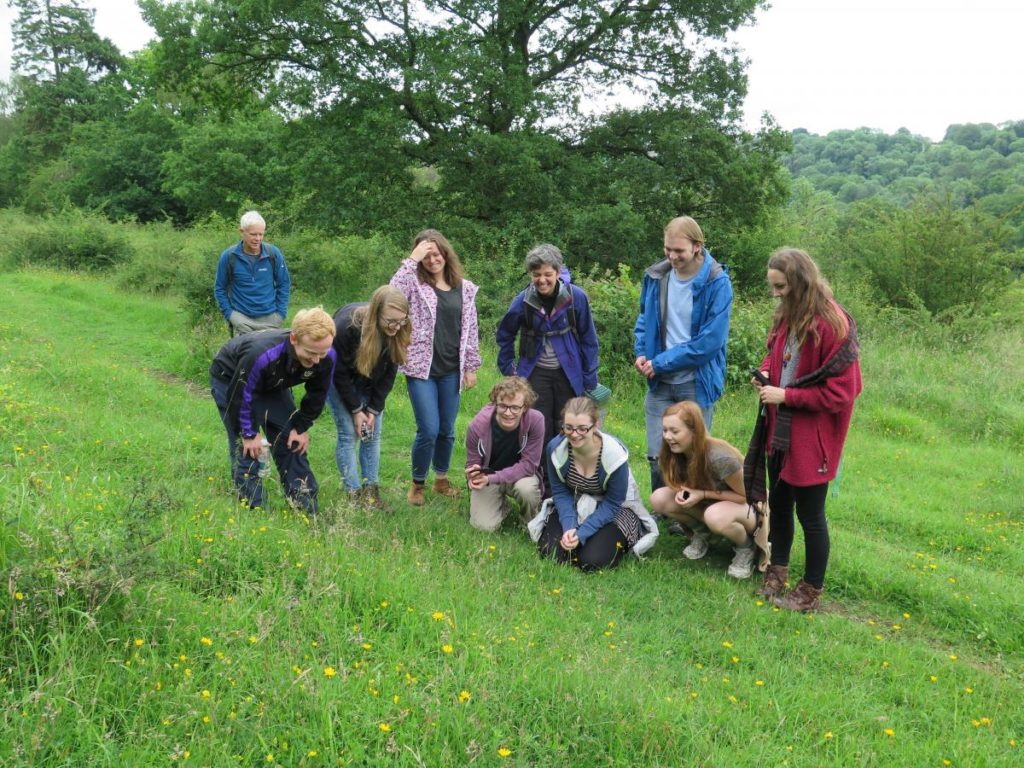 Undergraduate students studying insects at Daneway Banks (Image: Jeremy Thomas)
Undergraduate students studying insects at Daneway Banks (Image: Jeremy Thomas)
Daneway Banks was formally launched as a jointly owned nature reserve by HRH the Prince of Wales in July 2016.
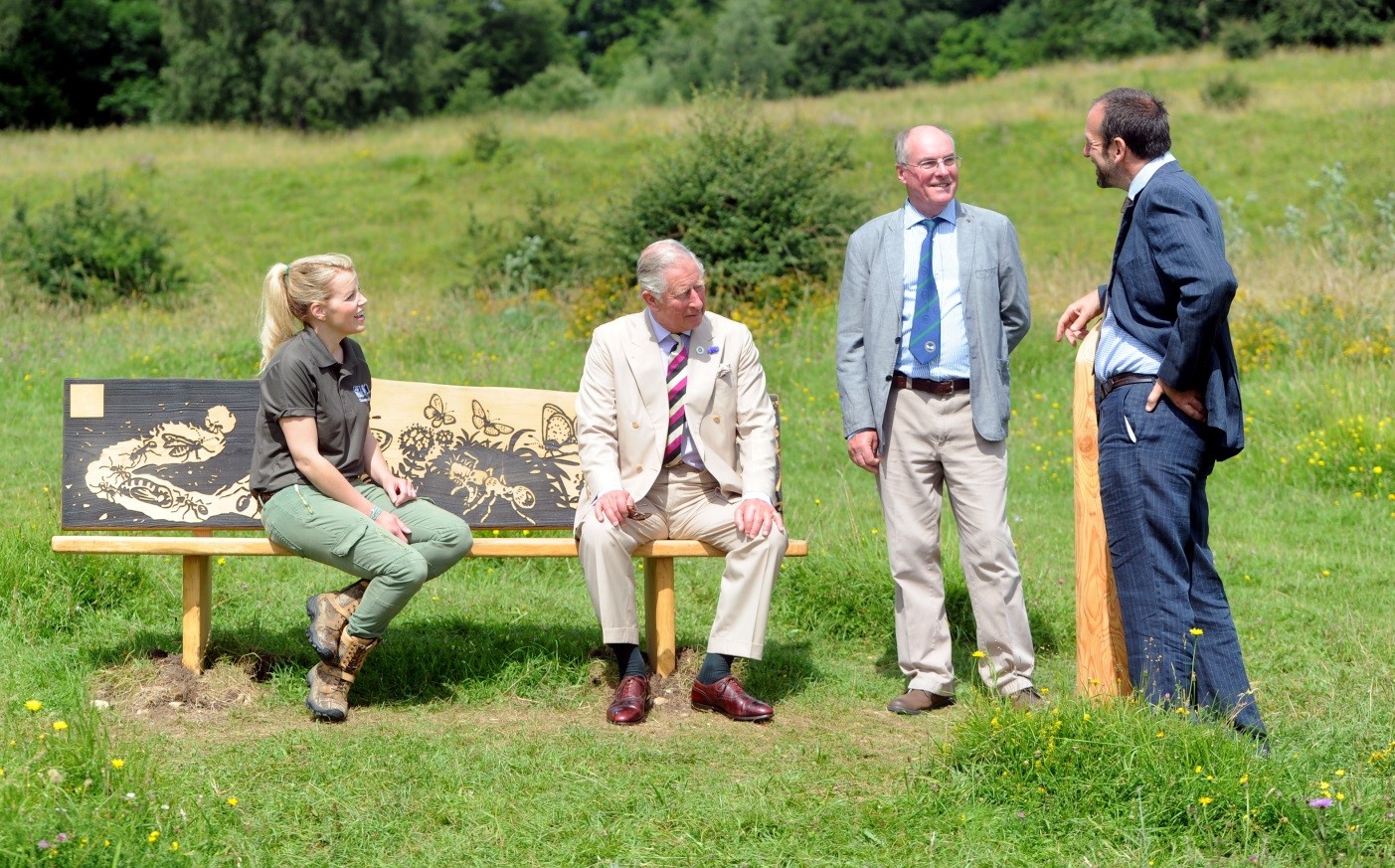 HRH The Prince of Wales seated with Ellie Harrison (GWT President) on a bench carved with illustrations of the Large Blue butterfly’s life cycle, during a tour of Daneway Banks with Prof Jeremy Thomas, Chairman of the RES Conservation Committee (centre) and Gloucestershire Wildlife Trust CEO Roger Mortlock. Image: Paul Nicholls
HRH The Prince of Wales seated with Ellie Harrison (GWT President) on a bench carved with illustrations of the Large Blue butterfly’s life cycle, during a tour of Daneway Banks with Prof Jeremy Thomas, Chairman of the RES Conservation Committee (centre) and Gloucestershire Wildlife Trust CEO Roger Mortlock. Image: Paul Nicholls

History
In 2014, the Gloucestershire Wildlife Trust approached the RES to explore co-ownership of Daneway Banks, a site they had rented since 1968 but which was now offered for sale. In addition to halving the capital cost, GWT would benefit from the expertise of RES Fellows in management recommendations, monitoring and scientific and educational input, whilst RES would help save and (co-)own a reserve that not only made a tangible contribution to insect diversity but was also amenable to entomological research and educational activities.

The Wildlife of Daneway Banks SSSI
Consisting of a series of south-east facing slopes and flatter strips overlying Jurassic limestone and some Fuller’s Earth, Daneway Banks is a beautiful downland as well as a species-rich one. The main sward is classed as Bromus erectus -Brachypodium pinnatum grassland (National Vegetation class CG5a), interspersed with patches of scrub and woodland, and occasional cliffs and scree from small abandoned quarries.
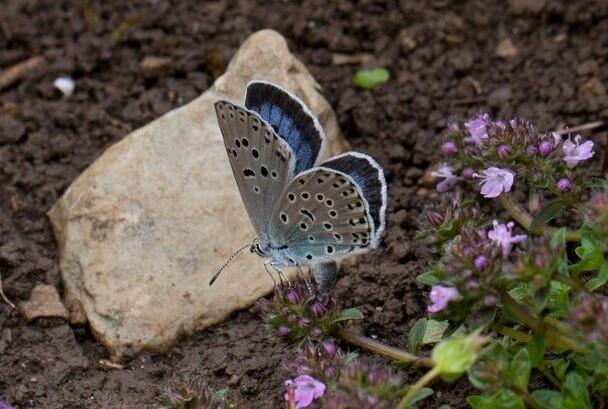
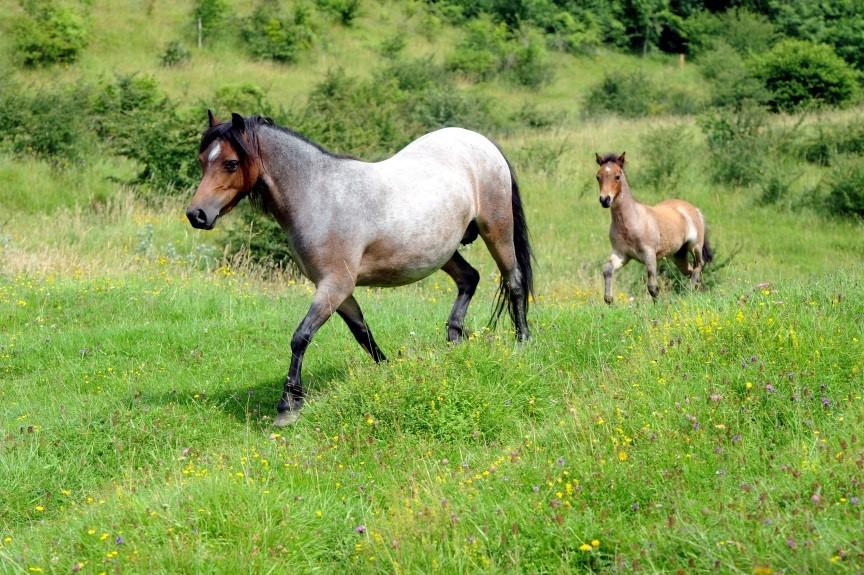 Adult Large Blue butterfly (left) laying eggs on the flowerbuds of wild thyme. Image: David Simcox
Adult Large Blue butterfly (left) laying eggs on the flowerbuds of wild thyme. Image: David Simcox
Welsh Mountain ponies (right) (and Norfolk Horn Sheep) from the Butts Ram Rare Breeds Centre graze Daneway Banks from autumn to early spring. Image: Jeremy Thomas
From mid-autumn to spring, Daneway Banks is grazed by Norfolk Horn sheep and Welsh Mountain ponies from the nearby Butts Farm Rare Breeds Centre, themselves an attractive feature of the site. By late winter the sward is predominantly short (with scattered taller patches) revealing an ant-scape of thousands of Yellow Meadow ant hills known locally as emmett casts – seen at their best when casting long shadows in the winter sun. The land is then left ungrazed through spring and summer, allowing a succession of flowers to bloom and set seed, and for insects to breed, in a sward that remains sparse and heterogeneous on its infertile soils. By mid-April, much of Daneway turns pale yellow with the blooms of cowslips, matched by Kidney vetch on thinner soils. These give way, respectively, to the deeper yellow and pinks of rock-rose and wild thyme during June, and by high summer marjoram and harebells in abundance make a purple-blue backdrop to the cerise of pyramidal orchids.
Interspersed among these prominent species grow a diversity of other calcareous plants. Of special interest are three national rarities, Cut leaved Germander Teucrium botrys, Cut-Leaved Selfheal Prunella laciniata, and Slender bedstraw Galium pumilium. Other Red Data or Nationally Notable plants include Frog Orchid Coeloglossum viride, Fly orchid Orchis insectifera, Musk orchid Herminium monorchis, Green-winger orchid Anacamptis morio (in hundreds), Greater butterfly orchid Platanthera chlorantha, Dwarf rock-bristle Seligeria pusilla, Angular Solomon’s-seal Polygonatum odoratus, Meadow saffron Colchicum autumnale, Hound’s-tongue,Cynoglossum officinale, Dwarf spurge Euphorbia exigua, and Sainfoin, Onobrychis viciifolia . Most, if not all, of these plants have increased, and in some cases reappeared after long absences, under ‘Large blue management’.
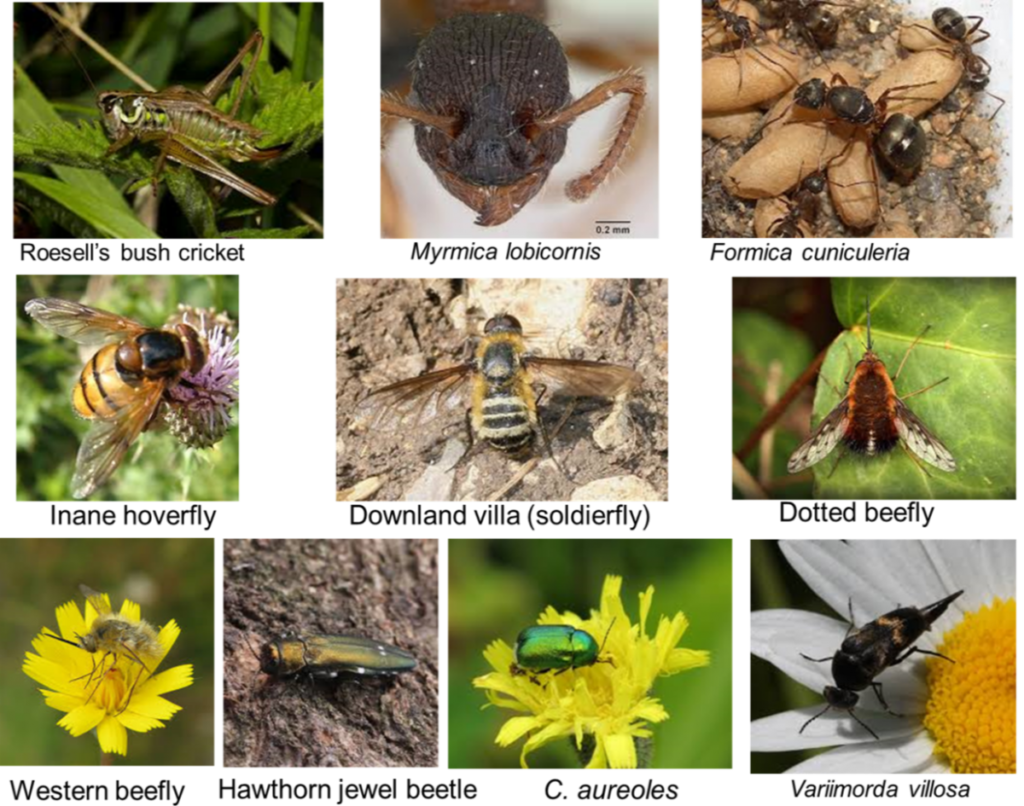 Some of the rarer insect species on Daneway Banks
Some of the rarer insect species on Daneway Banks
The diverse flora coupled with a warm but heterogeneous microclimate and soil structure supports an abundance of common and rare insects, which in turn are host to predatory and parasitic species. Insect life is noticeably abundant on the site. Among known rarities breeding in good numbers are four striking Diptera: Inane hoverfly Volucella inanis, Dotted bee-fly Bombylius discolor, Western bee-fly B. canescens and the Downland Villa Villa cingulata. The last is especially welcome since it was not reported from the UK during the second half of the 20th century, but has recently reappeared on a handful of calcareous sites, mainly in the Chilterns. The population at Daneway is exceptionally large, and the striped adults are readily seen flicking eggs onto the bare ground of paths and scrapes during high summer.
Other notable insects include the Hawthorn jewel beetle Cionus nigritarsis, Cryptocephalus aureoles, Variimorda villosa, glow-worm Lampyris noctiluca, Roesel’s bush-cricket Metrioptera roesolii, and the largest known UK population of the ant Myrmica lobicornis. Moths include the Knot grass Acronicta rumicis, Forester Adscita statices, Drad looper Minoa murinata, Shaded broad-bar Scotopteryx chenopodiata and Sulphur pearl Sitochroa palealis. Notable butterflies are the Small blue Cupido minimus (in abundance) Dark Green and SIlver-washed fritillaries, White-letter hairstreak, Dingy skipper, Grizzled skipper, and regular sightings of Marsh fritillary from a permanent colony nearby.
As hoped, The Duke of Burgundy Hamearis lucina hs returned to breed since 2019 on the abundant cowslips on Daneway, many of which now exist in optimum growth-forms for its specialist larvae. In the same year, the Pearl-bordered fritillary recolonised the newly-cut areas of coppice in high densities. But as yet only a small fraction of the suspected species on Daneway Banks has been described: the RES has commissioned a 2-year survey of the lesser known groups. We hope for more exciting discoveries to match those in 2017-18 of the rare Downland Robber fly Machimus rusticus and a nationally large population of the Rugged Oil beetle Meloe rugosus, known from just 30 other British sites.
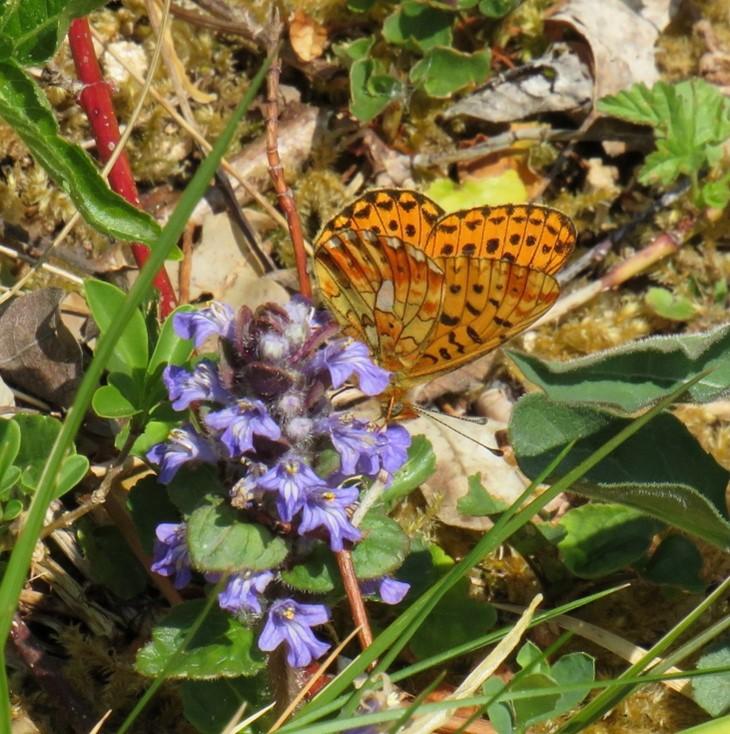
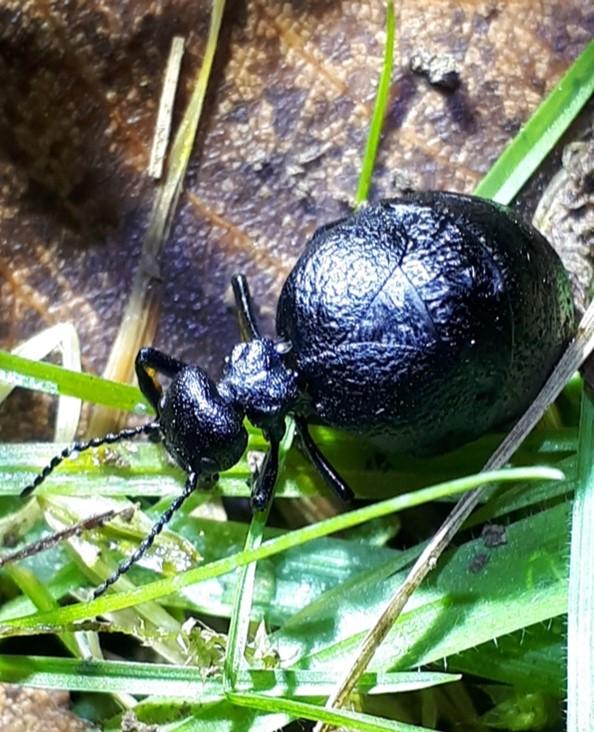 Pearl-bordered fritillaries (left) recently colonised the coppiced areas of Daneway Banks (image Alan Sumnall). Elsewhere, a large population of the rare Rugged Oil beetle (right) breeds across the thin-soiled upper slopes, where sweat bees – on whose pollen its kleptoparasitic larvae depend – occur in great abundance (image: Amanda Cox).
Pearl-bordered fritillaries (left) recently colonised the coppiced areas of Daneway Banks (image Alan Sumnall). Elsewhere, a large population of the rare Rugged Oil beetle (right) breeds across the thin-soiled upper slopes, where sweat bees – on whose pollen its kleptoparasitic larvae depend – occur in great abundance (image: Amanda Cox).
Rare vertebrates are not a feature of Daneway banks, although the more widespread species may be common. The site supports Common toad Bufo bufo, Grass snake Natrix natrix, Adder Vipera berus (in high numbers for the Cotswolds), Slow-worm Anguis fragilis, and Common lizard Zootoca vivipara. Breeding Birds include Skylark Alauda arvensis, Yellowhammer Emberiza citronella, Song thrush Turdus philomelos and Bullfinch Pyrrhula pyrrhula. Buzzards are ubiquitous overhead alongside the occasional Goshawk, and the downs frequently echo to the croak of raven. Dormice have also returned in fair numbers to breed in the freshly-cut coppices beloved by Pearl-bordered fritillaries.
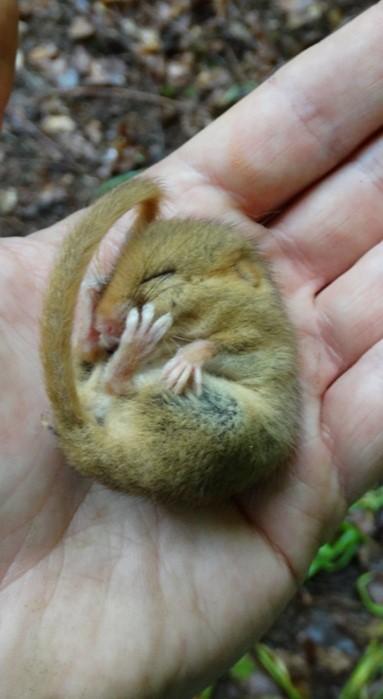
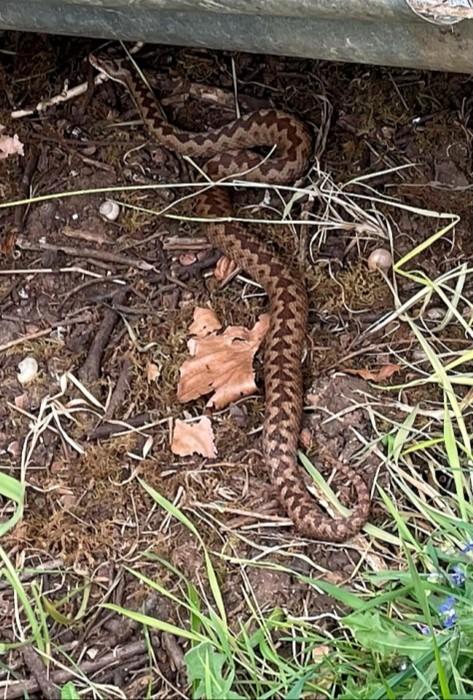
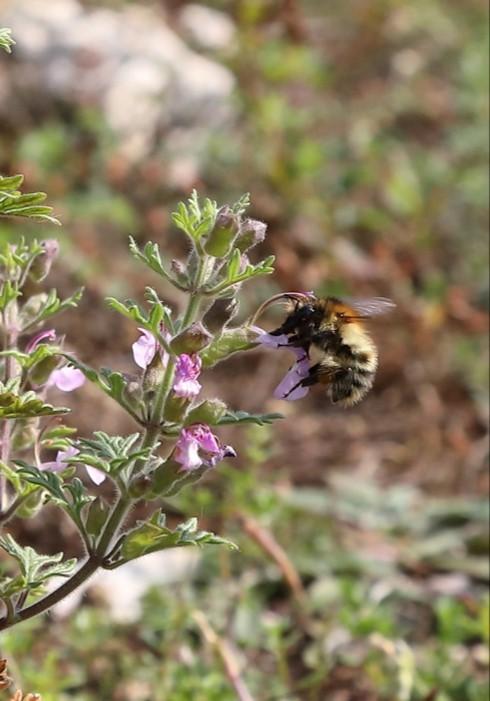 Conservation on Daneway banks is not just about insects! RES and GWT are proud that the Hazel Dormouse recently colonised our new coppiced areas (image Alan Sumnall), it also supports one of Gloucestershire’s last populations of Adder (image Jeremy Thomas), while Cut-leaved Germander (here providing nectar for the Common Carder bee) blooms in unprecedented numbers on Daneway – one of only six of its known UK localities (image Jeremy Thomas).
Conservation on Daneway banks is not just about insects! RES and GWT are proud that the Hazel Dormouse recently colonised our new coppiced areas (image Alan Sumnall), it also supports one of Gloucestershire’s last populations of Adder (image Jeremy Thomas), while Cut-leaved Germander (here providing nectar for the Common Carder bee) blooms in unprecedented numbers on Daneway – one of only six of its known UK localities (image Jeremy Thomas).

The Large Blue butterfly, Maculinea arion
 Adult Large Blue butterfly laying eggs on the flowerbuds of wild thyme. Image: David Simcox
Adult Large Blue butterfly laying eggs on the flowerbuds of wild thyme. Image: David Simcox
The Royal Entomological Society has a long association with the Large Blue butterfly: it is thus fitting that we now (co-)own a major site. The classic experiments by E.B. Purefoy, T.A. Chapman and F.W. Frohawk that revealed how its larvae, after briefly feeding on thyme flowerheads, live underground as social parasites eating Myrmica ant grubs, were first published in Trans./Proc. Ent. Soc. Lond. in 1915-19. Then in 1931, when insect conservation was almost unknown, the RES established the ‘Butterfly Valley’ reserve at The Dizzard, Cornwall, to protect one of the Large Blue’s finest sites. For 8 years butterfly collectors were excluded, but unfortunately the local farmer Mr. Samwin was also barred from swaling (gorse-burning) and grazing the site, and the colony became extinct. Undaunted, the RES led the calls for constraint among collectors throughout the 1940s and ‘50s, and in the 1948 sponsored a survey of West Country sites by Capt. R.A. Jackson. In 1963, represented by Graham Howarth, the RES was one of five founders of The Joint Committee for the Conservation of the Large Blue Butterfly, the consortium that still leads the national programme to restore this species. And in 2002, the Society commissioned a portrait of the Large Blue as a present to its patron, The Queen, in celebration of her Golden Jubilee.
The Cotswolds was one of three main regions (of six) where the Large Blue butterfly bred before its extinction as a UK species in 1979. Although a classic collecting ground for this most coveted of butterflies, the credentials of only 11 out of c.32 Cotswold ‘sites’ rest on more than a single record, and just four of them, including Daneway Banks, have records spanning more than 50 years. The earliest account for it at Daneway, or indeed anywhere in the Cotswolds, was by R.E. Trye in 1858; the last definite one is for 1947, although it probably persisted until 1951 when, according to Peter Crow, “a schoolmaster from Minchinhampton helped ‘clear out’ the locality by inviting parties of boys at the school to Large Blue catching excursions”. In fact collectors are unlikely to have been more than the final straw for a population that, like all others, was in steep decline due to the progressive abandonment of the Large Blue’s unproductive swards by farmers, and later through the loss of rabbits to myxomatosis.
The story of the Large Blue larva’s chemical and acoustical mimicry of – and dependency on – a single species of Myrmica ant rather than any of its three more common congeners (or Lasius flavus) as was previously supposed are told by Jeremy Thomas (1998, 2003) in RES symposium volumes 19 and 21.
The story of the restoration of appropriate habitat for the Large Blue by a consortium of 14 scientific and conservation organisations, directed by David Simcox and Jeremy Thomas, to currently 40 now-occupied UK nature reserves and other sites, and the successful re-introduction of a near identical race of Large Blue from Sweden in 1983 (Devon) and 1992 (Somerset and Gloucestershire), is also too familiar to describe in detail here.
We struggled, however, in the Cotswolds. There, the early introductions to Rough Banks and Barnsley Warren failed because the adult butterflies emerged too late to synchronise with flower-bud production of thyme.
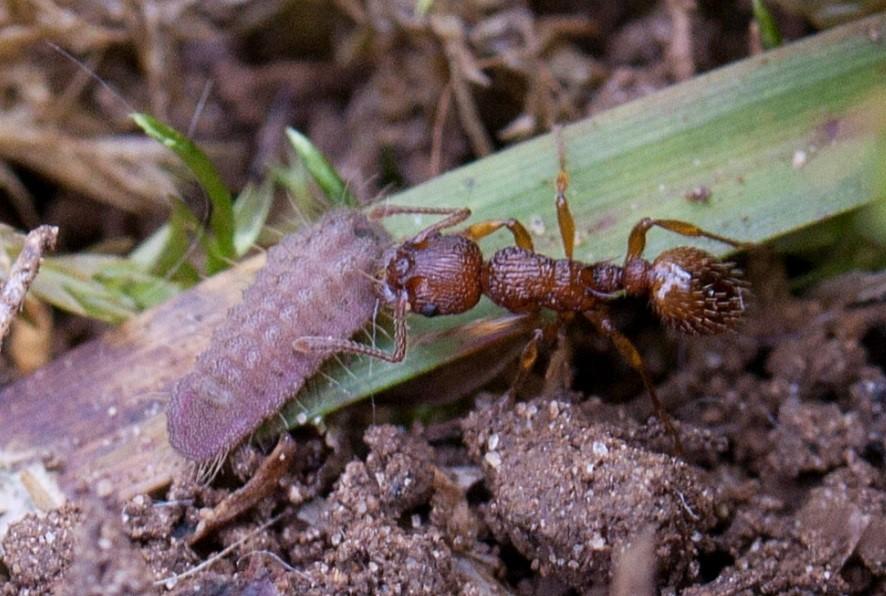 Large Blue larva being ‘milked’ for secretions by a Myrmica sabuleti worker prior its larva’s adoption into the ant nest. Daneway Banks. At this stage it weighs c 1% of its final body mass. Image: David Simcox
Large Blue larva being ‘milked’ for secretions by a Myrmica sabuleti worker prior its larva’s adoption into the ant nest. Daneway Banks. At this stage it weighs c 1% of its final body mass. Image: David Simcox
Daneway Banks always seemed a more promising site for restoration. At the nadir of under-grazing in the 1970s-80s, 10% of its thyme plants still remained within foraging range of Myrmica sabuleti, nowhere near enough for the Large blue yet among the highest then in the Cotswolds. Gradually, ant densities increased and thyme spread, reaching 65% co-occurrence in 1998 and >90% since 2010 under GWT’s targeted grazing. David Simcox’s and Jeremy Thomas’ trial introduction of Large blues to Daneway, from a thriving colony on Somerset Wildlife Trust’s Green Down, initially produced promising results in 2001-04, with growth matching model predictions. However, continuity of grazing proved elusive with the then grazier, and ceased after a severe incidence of bovine TB, causing the ant to decline and the butterfly to disappear.
A second introduction by Simcox and Sarah Meredith in 2010 was successful. Exemplary management under a new grazier has achieved optimum habitat at Daneway, and by 2014-16 it already supported the second largest population of Large blue in the country, with an estimated 101, 831 eggs laid in 2016, equivalent to roughly 4,000 adults. In addition to the improved habitat to oviposit on Marjoram – its early foodplant in southern Europe – which flowers later than thyme. We used both colonies as sources for the 2010 introduction, since both plants are widespread on Daneway, roughly doubling the number of accessible Myrmica sabuleti nests than if thyme alone were exploited. Another adaptation from the Somerset populations has been of increased adult dispersal by this normally sedentary species as it spread by stepping-stone colonisation to new sites across the landscape. This attribute, together with back-up plans for emergency grazing if ever needed, make us confident of long-term success on Daneway and wider afield in the Cotswolds, as other reserves receive similar management.
Thanks to both the RES’s collaborative Prince of Wales’s fund and Golden Valley restorations, these already support a meta-population of Large blue colonies, with Daneway at the core, each able to repopulate its neighbours by natural dispersal should a local loss occur.
Large blue butterflies at Daneway Banks with Alan Sumnall, lead land manager east at Gloucestershire Wildlife Trust

Visiting Daneway Banks
Fellows and Members are encouraged to visit Daneway Banks, which is located at OS grid reference SO937034, half a mile west of the village of Sapperton and 1 mile north (as the insect flies) of the A419, midway between Stroud and Cirencester. The main entrance is 250 yards north of the Daneway Inn pub.
Please note that apart from in Sapperton, very few parking spaces are available except in the pub carpark, which visitors are welcome to use so long as they also patronise the pub, which provides excellent food and, in season, a special brew of ‘Rare Find’ golden ale. The site is especially busy during the main Large Blue flight period, from mid-June to mid-July.
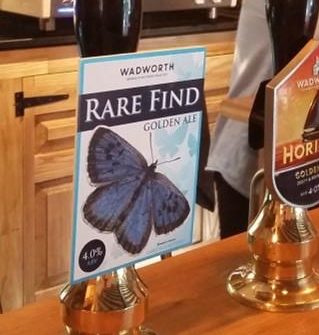 Rare Find Ale on tap
Rare Find Ale on tap
The excellent Daneway Inn boasts a special brew celebrating the Large blue butterfly

Insect Biological Recording
Please submit any records of insects (and other wildlife) seen to Luke Tilley (luke@royensoc.co.uk).
To avoid confusion and potential embarrassment, it is essential to obtain prior permission before taking collecting equipment onto the site, and since it is an SSSI, formal permission is also required from Natural England to collect or remove specimens.
For private visits, please also keep to the footpath or the additional routes indicated on the site map. Despite some inevitable constraints due to the vulnerability of this site, please visit and enjoy our wonderful new reserve.
The RES proudly co-owns Daneway Banks with the Gloucestershire Wildlife Trust (GWT) and would like to thank the many RES Fellows and staff, and GWT members and staff that helped and took part in the process of approving and acquiring Daneway Banks. Particular thanks must go to Prof Jeremy Thomas (RES Conservation Committee, Chair), David Simcox and Sarah Meredith (Large Blue Project Consortium) and Grundon – waste management, environmental and recycling solutions.
More information about Daneway Banks SSSI can be found on our partner’s website, the Gloucestershire Wildlife Trust
For more information about the Large Blue butterfly, please visit UK Butterflies.